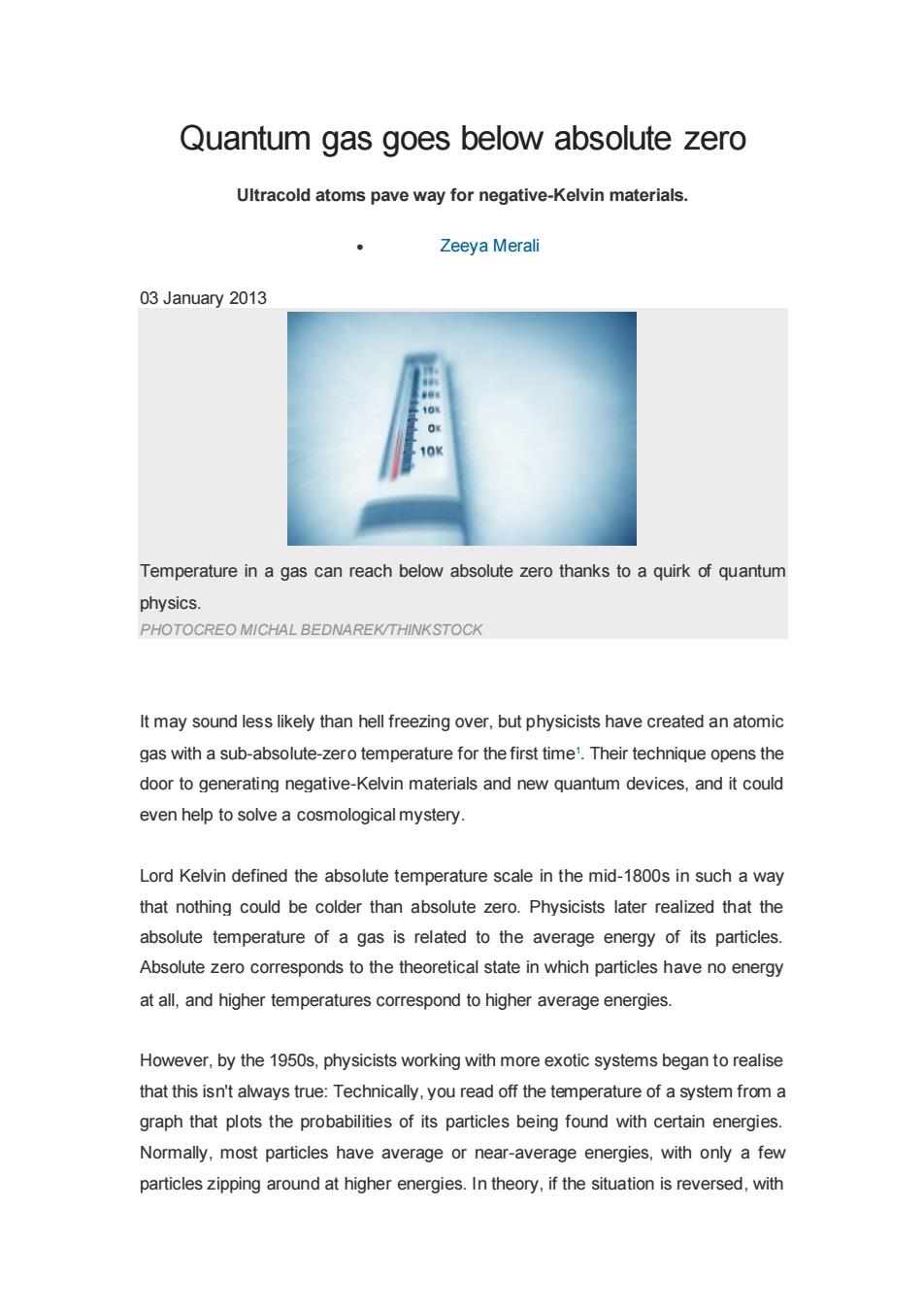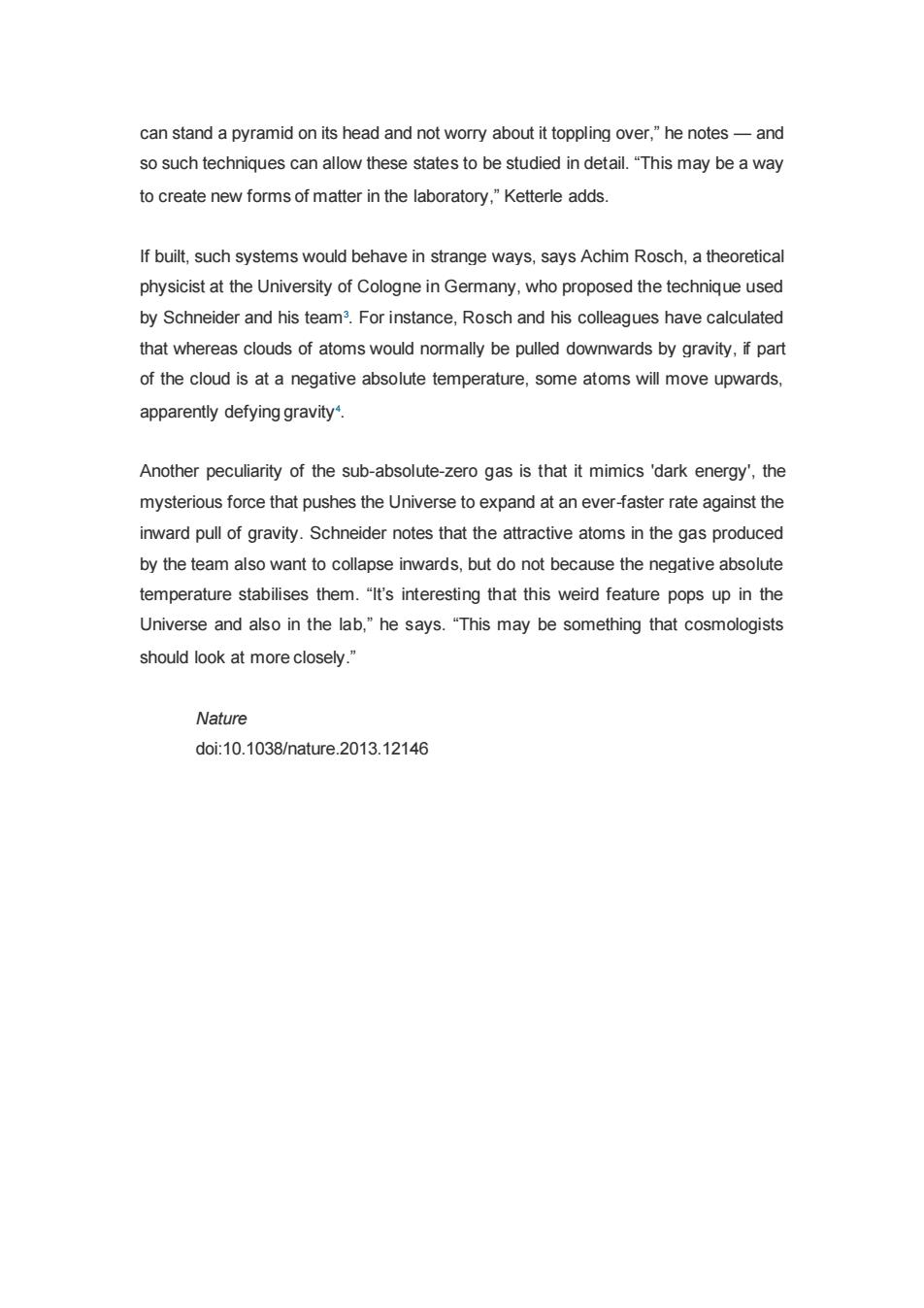
Quantum gas goes below absolute zero Ultracold atoms pave way for negative-Kelvin materials Zeeya Merali 03 January 2013 Temperature in a gas can reach below absolute zero thanks to a quirk of quantum physics. PHOTOCREO MICHAL BEDNAREK/THINKSTOCK It may sound less likely than hell freezing over,but physicists have created an atomic gas with a sub-absolute-zero temperature for the first time'.Their technique opens the door to generating negative-Kelvin materials and new quantum devices,and it could even help to solve a cosmological mystery Lord Kelvin defined the absolute temperature scale in the mid-1800s in such a way that nothing could be colder than absolute zero.Physicists later realized that the absolute temperature of a gas is related to the average energy of its particles. Absolute zero corresponds to the theoretical state in which particles have no energy at all,and higher temperatures correspond to higher average energies. However,by the 190s,physicists working with more exotic systems began to realise that this isn't always true:Technically,you read off the temperature of a system from a graph that plots the probabilities of its particles being found with certain energies. Normally,most particles have average or near-average energies,with only a few particles zipping around at higher energies.In theory.if the situation is reversed.with
Quantum gas goes below absolute zero Ultracold atoms pave way for negative-Kelvin materials. • Zeeya Merali 03 January 2013 Temperature in a gas can reach below absolute zero thanks to a quirk of quantum physics. PHOTOCREO MICHAL BEDNAREK/THINKSTOCK It may sound less likely than hell freezing over, but physicists have created an atomic gas with a sub-absolute-zero temperature for the first time1 . Their technique opens the door to generating negative-Kelvin materials and new quantum devices, and it could even help to solve a cosmological mystery. Lord Kelvin defined the absolute temperature scale in the mid-1800s in such a way that nothing could be colder than absolute zero. Physicists later realized that the absolute temperature of a gas is related to the average energy of its particles. Absolute zero corresponds to the theoretical state in which particles have no energy at all, and higher temperatures correspond to higher average energies. However, by the 1950s, physicists working with more exotic systems began to realise that this isn't always true: Technically, you read off the temperature of a system from a graph that plots the probabilities of its particles being found with certain energies. Normally, most particles have average or near-average energies, with only a few particles zipping around at higher energies. In theory, if the situation is reversed, with

more particles having higher,rather than lower,energies,the plot would flip over and the sign of the temperature would change from a positive to a negative absolute temperature,explains Ulrich Schneider,a physicist at the Ludwig Maximilian University in Munich,Germany Peaks and valleys Related stories Super gas meets with no resistance Simulation:Quantum leaps Cameras to focus on dark energy More related stories Schneider and his colleagues reached such sub-absolute-zero temperatures with an ultracold quantum gas made up of potassium atoms.Using lasers and magnetic fields they kept the individual atoms in a lattice arrangement.At positive temperatures.the atoms repel,making the configuration stable.The team then quickly adjusted the magnetic fields,causing the atoms to attract rather than repel each other."This suddenly shifts the atoms from their most stable,lowest-energy state to the highest possible energy state,before they can react,"says Schneider."It's like walking through a valley,then instantly finding yourself on the mountain peak." At positive temperatures,such a reversal would be unstable and the atoms would collapse inwards.But the team also adjusted the trapping laser field to make it more energetically favourable for the atoms to stick in their positions.This result,described today in Science',marks the gas's transition from just above absolute zero to a few billionths of a Kelvin below absolute zero. Wolfgang Ketterle.a physicist and Nobel laureate at the Massachusetts Institute of Technology in Cambridge,who has previously demonstrated negative absolute temperatures in a magnetic system2,calls the latest work an"experimental tour de force.Exotic high-energy states that are hard to generate in the laboratory at positive temperatures become stable at negative absolute temperatures-"as though you
more particles having higher, rather than lower, energies, the plot would flip over and the sign of the temperature would change from a positive to a negative absolute temperature, explains Ulrich Schneider, a physicist at the Ludwig Maximilian University in Munich, Germany. Peaks and valleys Related stories • Super gas meets with no resistance • Simulation: Quantum leaps • Cameras to focus on dark energy More related stories Schneider and his colleagues reached such sub-absolute-zero temperatures with an ultracold quantum gas made up of potassium atoms. Using lasers and magnetic fields, they kept the individual atoms in a lattice arrangement. At positive temperatures, the atoms repel, making the configuration stable. The team then quickly adjusted the magnetic fields, causing the atoms to attract rather than repel each other. “This suddenly shifts the atoms from their most stable, lowest-energy state to the highest possible energy state, before they can react,” says Schneider. “It’s like walking through a valley, then instantly finding yourself on the mountain peak.” At positive temperatures, such a reversal would be unstable and the atoms would collapse inwards. But the team also adjusted the trapping laser field to make it more energetically favourable for the atoms to stick in their positions. This result, described today in Science1 , marks the gas’s transition from just above absolute zero to a few billionths of a Kelvin below absolute zero. Wolfgang Ketterle, a physicist and Nobel laureate at the Massachusetts Institute of Technology in Cambridge, who has previously demonstrated negative absolute temperatures in a magnetic system2 , calls the latest work an “experimental tour de force”. Exotic high-energy states that are hard to generate in the laboratory at positive temperatures become stable at negative absolute temperatures — “as though you

can stand a pyramid on its head and not worry about it toppling over,"he notes-and so such techniques can allow these states to be studied in detail."This may be a way to create new forms of matter in the laboratory,"Ketterle adds. If built,such systems would behave in strange ways,says Achim Rosch,a theoretical physicist at the University of Cologne in Germany,who proposed the technique used by Schneider and his team3.For instance,Rosch and his colleagues have calculated that whereas clouds of atoms would normally be pulled downwards by gravity,if part of the cloud is at a negative absolute temperature,some atoms will move upwards, apparently defying gravity4. Another peculiarity of the sub-absolute-zero gas is that it mimics 'dark energy',the mysterious force that pushes the Universe to expand at an ever-faster rate against the inward pull of gravity.Schneider notes that the attractive atoms in the gas produced by the team also want to collapse inwards,but do not because the negative absolute temperature stabilises them."It's interesting that this weird feature pops up in the Universe and also in the lab,"he says."This may be something that cosmologists should look at more closely." Nature doi:10.1038/nature.2013.12146
can stand a pyramid on its head and not worry about it toppling over,” he notes — and so such techniques can allow these states to be studied in detail. “This may be a way to create new forms of matter in the laboratory,” Ketterle adds. If built, such systems would behave in strange ways, says Achim Rosch, a theoretical physicist at the University of Cologne in Germany, who proposed the technique used by Schneider and his team3 . For instance, Rosch and his colleagues have calculated that whereas clouds of atoms would normally be pulled downwards by gravity, if part of the cloud is at a negative absolute temperature, some atoms will move upwards, apparently defying gravity4 . Another peculiarity of the sub-absolute-zero gas is that it mimics 'dark energy', the mysterious force that pushes the Universe to expand at an ever-faster rate against the inward pull of gravity. Schneider notes that the attractive atoms in the gas produced by the team also want to collapse inwards, but do not because the negative absolute temperature stabilises them. “It’s interesting that this weird feature pops up in the Universe and also in the lab,” he says. “This may be something that cosmologists should look at more closely.” Nature doi:10.1038/nature.2013.12146